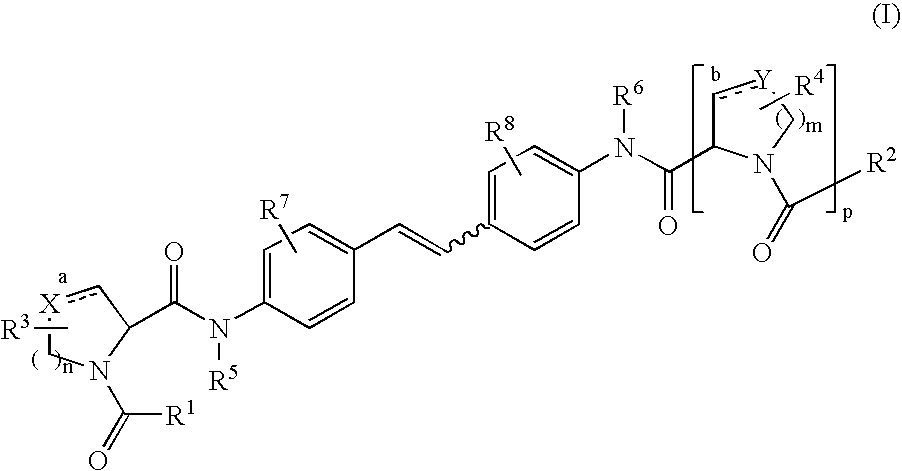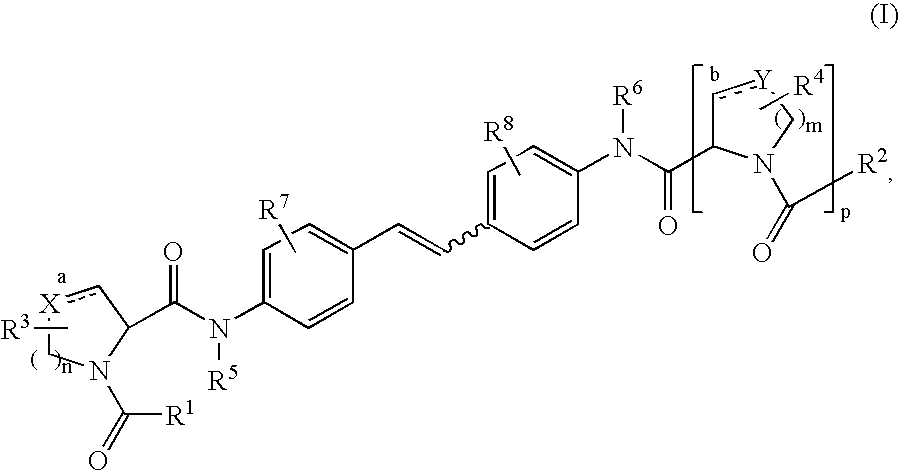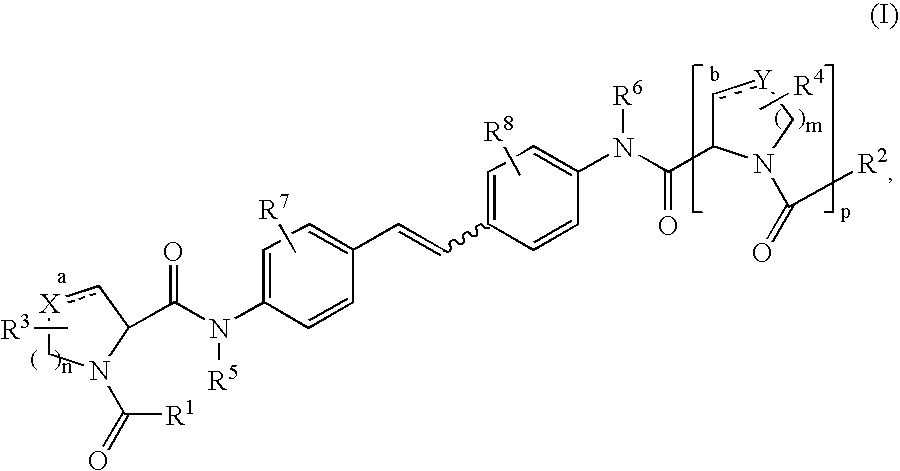Inhibitors of HCV replication
a technology of hcv replication and inhibitors, which is applied in the field of antiviral compounds, can solve the problems that none of the compounds have, to date, progressed beyond clinical trials, and a substantial fraction of patients do not have a sustained reduction in viral load, and achieve the effect of inhibiting the function of the ns5a protein
- Summary
- Abstract
- Description
- Claims
- Application Information
AI Technical Summary
Benefits of technology
Problems solved by technology
Method used
Image
Examples
example 1
[0239] 2-Ethoxy-1-ethoxycarbonyl-1,2-dihydroquinoline (EEDQ, 22.58 g, 91.3 mmol) was added in one portion to a stirred suspension of 4,4′-diaminostilbene (8.0 g, 38.05 mmol) and N-BOC-L-proline (18.83 g, 87.5 mmol) in dry dichloromethane (250 mL) under nitrogen at room temperature. After 15 minutes the suspension became homogeneous and was stirred further for 16 hours before nearly all of the dichloromethane was removed in vacuo. The residue was then triturated with ethyl acetate and diethyl ether and filtered to provide the desired product (94% pure, 21.62 g, 94% yield) as an off-white solid: 1H NMR (DMSO-d6, 400 MHz) δ 10.04 (s, 2H), 7.61 (d, J=8.8 Hz, 4H), 7.51 (d, J=8.4 Hz, 4H), 7.09 (s, 2H), 4.30-4.17 (2m, 2H), 3.45-3.34 (2m, 4H), 2.25-2.12 (m, 2H), 1.95-1.72 (2m, 6H), 1.40 and 1.27 (2s, 18H); LCMS (Rt=2.56 min, m / z 605.4).
[0240] Following the procedure described in Example 1 and substituting the appropriate reagents, the following compounds were prepared:
HPLC(min / Ex-meth-(M...
example 23a
[0242] A suspension of Example 1 (21.6 g, 35.72 mmol) in dry dichloromethane (500 mL) was treated with trifluoroacetic acid (50 mL) at room temperature under nitrogen. The mixture was stirred for 3 hours before additional TFA (20 mL) was added. After stirring for an additional 4 hours at room temperature, the mixture was concentrated in vacuo. The residue was dissolved in ethyl acetate, washed with 1N sodium hydroxide solution and brine, and evaporated to ¼ of its original volume to provide the desired product (11.21 g, 77.6%) as a white solid: 1H NMR (DMSO-d6, 500 MHz) δ 9.99 (s, 2H), 7.66 (d, J=8.5 Hz, 4H), 7.51 (d, J=8.5 Hz, 4H), 7.10 (s, 2H), 3.68 (dd, J=8.8, 6.0 Hz, 2H), 3.05 (br s, 2H), 2.89 (t, J=7.0 Hz, 4H), 2.07-2.01 (m, 2H), 1.80-1.75 (m, 2H), 1.68-1.64 (m, 4); LCMS (Rt=1.20 min, m / z 405.43).
example 23b
[0243] O-(7-Azabenzotriazol-1-yl)-N,N,N′,N′-tetramethyluronium hexafluorophosphate (HATU, 108 mg, 0.28 mmol) was added in one portion to a solution of Example 23A (50 mg, 0.123 mmol), 2,5-dimethoxybenzoic acid (49.5 mg, 0.27 mmol) and diisopropylethylamine (80 μL, 0.49 mmol) in anhydrous DMF (1 mL). The mixture was stirred at room temperature for 3 hours before it was purified by reverse-phase preparative HPLC to provide the desired product (63.8 mg, 70.8%) as a white solid: 1H NMR (DMSO-d6, 500 MHz) δ 10.08 and 9.63 (2s, 2H),7.65-7.37 (series of m, 8H), 7.13 and 6.59 (series of m, 8H), 4.57-4.54 and 4.18-4.16 (2m, 2H 3.77 and 3.71 (2s, 6H), 3.73-3.48 (series of m, 8H), 3.36-3.22 (m, 2H), 2.29-2.17 (m, 2H), 2.01-1.75 (2m, 6H); LCMS (Rt=2.29 min, m / z 733.4).
[0244] Following the procedure described in Examples 23A and 23B and substituting the appropriate reagents, the following compounds were prepared. Unsymmetrical analogs were prepared in identical fashion to Example 23 except that...
PUM
| Property | Measurement | Unit |
|---|---|---|
| Current | aaaaa | aaaaa |
| Digital information | aaaaa | aaaaa |
| Mass | aaaaa | aaaaa |
Abstract
Description
Claims
Application Information
 Login to View More
Login to View More - R&D
- Intellectual Property
- Life Sciences
- Materials
- Tech Scout
- Unparalleled Data Quality
- Higher Quality Content
- 60% Fewer Hallucinations
Browse by: Latest US Patents, China's latest patents, Technical Efficacy Thesaurus, Application Domain, Technology Topic, Popular Technical Reports.
© 2025 PatSnap. All rights reserved.Legal|Privacy policy|Modern Slavery Act Transparency Statement|Sitemap|About US| Contact US: help@patsnap.com



